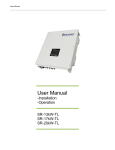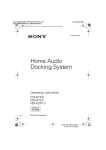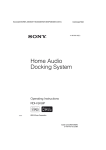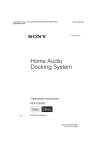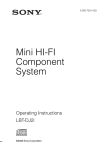Download Wireless Speaker System
Transcript
3-288-619-11(1) Wireless Speaker System This equipment complies with IC radiation exposure limits set forth for uncontrolled equipment and meets the RSS-102 of the IC radio frequency (RF) Exposure rules. Notice for the customers in Australia AIR-SA10 For the wireless transceiver (EZW-RT10) This equipment should be installed and operated with at least 20cm and more between the radiator and person’s body (excluding extremities: hands, wrists, feet and ankles). Printed in China WARNING To reduce the risk of fire or electric shock, do not expose this apparatus to rain or moisture. Indoor use only. To reduce the risk of fire, do not cover the ventilation opening of the apparatus with newspapers, tablecloths, curtains, etc. Do not place the naked flame sources such as lighted candles on the apparatus. To reduce the risk of fire or electric shock, do not expose this apparatus to dripping or splashing, and do not place objects filled with liquids, such as vases, on the apparatus. As the main plug is used to disconnect the unit from the mains, connect the unit to an easily accessible AC outlet. Should you notice an abnormality in the unit, disconnect the main plug from the AC outlet immediately. The unit is not disconnected from the mains as long as it is connected to the AC outlet, even if the unit itself has been turned off. Do not install the appliance in a confined space, such as a bookcase or built-in cabinet. The nameplate is located on the bottom exterior. Notice for the customers in the U.S.A. The following indications are located on the bottom exterior. This symbol is intended to alert the user to the presence of uninsulated “dangerous voltage” within the product’s enclosure that may be of sufficient magnitude to constitute a risk of electric shock to persons. This symbol is intended to alert the user to the presence of important operating and maintenance (servicing) instructions in the literature accompanying the appliance. Owner’s Record The model and serial numbers are located on the bottom of the unit. Record these numbers in the space provided below. Refer to them whenever you call upon your Sony dealer regarding this product. Model No. Serial No. Important Safety Instructions 1) 2) 3) 4) 5) 6) 7) For the wireless transceiver (EZW-RT10) This device complies with RSS-Gen of IC Rules. Operation is subject to the following two conditions: (1) this device may not cause interference, and (2) this device must accept any interference, including interference that may cause undesired operation of the device. This equipment should be installed and operated with at least 20cm and more between the radiator and person’s body (excluding extremities: hands, wrists, feet and ankles). Operating Instructions © 2008 Sony Corporation Notice for the customers in Canada Read these instructions. Keep these instructions. Heed all warnings. Follow all instructions. Do not use this apparatus near water. Clean only with dry cloth. Do not block any ventilation openings. Install in accordance with the manufacturer’s instructions. 8) Do not install near any heat sources such as radiators, heat registers, stoves, or other apparatus (including amplifiers) that produce heat. 9) Do not defeat the safety purpose of the polarized or grounding-type plug. A polarized plug has two blades with one wider than the other. A grounding type plug has two blades and a third grounding prong. The wide blade or the third prong are provided for your safety. If the provided plug does not fit into your outlet, consult an electrician for replacement of the obsolete outlet. 10)Protect the power cord from being walked on or pinched particularly at plugs, convenience receptacles, and the point where they exit from the apparatus. 11)Only use attachments/accessories specified by the manufacturer. 12)Use only with the cart, stand, tripod, bracket, or table specified by the manufacturer, or sold with the apparatus. When a cart is used, use caution when moving the cart/apparatus combination to avoid injury from tip-over. 13)Unplug this apparatus during lightning storms or when unused for long periods of time. 14)Refer all servicing to qualified service personnel. Servicing is required when the apparatus has been damaged in any way, such as power-supply cord or plug is damaged, liquid has been spilled or objects have fallen into the apparatus, the apparatus has been exposed to rain or moisture, does not operate normally, or has been dropped. The following FCC statement applies only to the version of this model manufactured for sale in the U.S.A. Other versions may not comply with FCC technical regulations. NOTE: This equipment has been tested and found to comply with the limits for a Class B digital device, pursuant to Part 15 of the FCC Rules. These limits are designed to provide reasonable protection against harmful interference in a residential installation. This equipment generates, uses and can radiate radio frequency energy and, if not installed and used in accordance with the instructions, may cause harmful interference to radio communications. However, there is no guarantee that interference will not occur in a particular installation. If this equipment does cause harmful interference to radio or television reception, which can be determined by turning the equipment off and on, the user is encouraged to try to correct the interference by one or more of the following measures: Reorient or relocate the receiving antenna. Increase the separation between the equipment and receiver. Connect the equipment into an outlet on a circuit different from that to which the receiver is connected. Consult the dealer or an experienced radio/TV technician for help. “S-AIR” and its logo are trademarks of Sony Corporation. The Bluetooth word mark and logos are owned by the Bluetooth SIG, Inc. and any use of such marks by Sony Corporation is under license. Other trademarks and trade names are those of their respective owners. Precautions Notes on use of the S-AIR product Preparing the unit Connect the unit and S-AIR main unit to listen to sound from the S-AIR main unit. As the S-AIR product transmits sound by radio waves, sound may skip when radio waves are obstructed. This is a characteristic of radio waves and is not a malfunction. As the S-AIR product transmits sound by radio waves, equipment that generates electromagnetic energy, such as a microwave oven, may interfere with sound transmission. As the S-AIR product uses the radio waves that share the same frequency as other wireless systems, such as wireless LAN or Bluetooth devices, interference or poor transmission may result. In this case, take the following steps: Do not install the S-AIR product near other wireless systems. Do not use the S-AIR product and the other wireless systems at the same time. The transmission distance differs depending on the usage environment. Find a location where transmission between the unit and the S-AIR main unit is most effective, and install the unit and the SAIR main unit there. EZW-RT10/Wireless transceiver Wall socket On safety Completely disconnect the power cord (mains lead) from the wall socket (mains) if it is not going to be used for an extended period of time. When unplugging the unit, always grip the plug. Never pull the cord itself. Should any solid object or liquid get into the unit, unplug the unit, and have it checked by qualified personnel before operating it again. The AC power cord can be changed only by a qualified service facility. On placement Do not place the unit in an inclined position or in locations that are extremely hot, cold, dusty, dirty, or humid or lacking adequate ventilation, or subject to vibration, direct sunlight or a bright light. Be careful when placing the unit on surfaces that have been specially treated (for example, with wax, oil, polish) as staining or discoloration of the surface may result. On heat buildup Heat buildup on the unit during operation is normal and is not cause for alarm. Do not touch the cabinet if it has been used continuously at a high volume because the cabinet may have become hot. Do not obstruct the ventilation holes. On the speaker system This speaker system is not magnetically shielded, and the picture on nearby TV sets may become magnetically distorted. In this situation, turn off the TV, wait about 15 to 30 minutes, and turn it back on. If there is no improvement, move the unit far away from the TV. Cleaning the cabinet Clean this unit with a soft dry cloth. Do not use any type of abrasive pad, scouring powder, or solvent, such as thinner, benzine, or alcohol. 1 Insert the supplied wireless transceiver (EZW-RT10) securely into the EZW-RT10 slot on the rear of the unit. Check the orientation of the mark when inserting the supplied wireless transceiver (EZW-RT10). Failure to do so may result in damage to the unit. 2 Set the S-AIR ID of the unit to the same S-AIR ID as the S-AIR main unit to be connected. For details on setting the S-AIR ID of the S-AIR main unit, refer to the Operating Instructions supplied with the S-AIR main unit. 3 Connect the power cord to a wall socket. If the plug does not fit the wall socket, detach the supplied plug adaptor (only for models equipped with an adaptor). 4 Press to turn on the unit. 5 Operate the S-AIR main unit to turn on the S-AIR function. For details on turning on the S-AIR function, refer to the Operating Instructions supplied with the S-AIR main unit. Once the connection is established, the S-AIR indicator on the front of the unit lights up and “LINKED” appears in the display for about 2 seconds. If you cannot connect to the S-AIR main unit It is easy to set the same S-AIR ID for the unit and SAIR main unit to establish the connection. However, if a neighbor has an S-AIR main unit with the same S-AIR ID as your S-AIR main unit, you may be able to hear the audio transmitted from your neighbor’s S-AIR main unit on your system. To prevent this, you can identify the unit with a specific S-AIR main unit by performing the pairing operation. When you perform pairing Before pairing, the connection is established by the SAIR ID (example). Your system This unit ID A CAUTION You are cautioned that any changes or modifications not expressly approved in this manual could void your authority to operate this equipment. For the wireless transceiver (EZW-RT10) This device complies with Part 15 of the FCC Rules. Operation is subject to the following two conditions: (1) this device may not cause harmful interference, and (2) this device must accept any interference received, including interference that may cause undesired operation. This equipment should be installed and operated with at least 20cm and more between the radiator and person’s body (excluding extremities: hands, wrists, feet and ankles). ID A ID A S-AIR main unit S-AIR main unit The connection is established between the paired unit and S-AIR main unit. Your system Neighboring system This unit ID A This equipment must not be co-located or operated in conjunction with any other antenna or transmitter. This equipment complies with FCC radiation exposure limits set forth for uncontrolled equipment and meets the FCC radio frequency (RF) Exposure Guidelines in Supplement C to OET65. Neighboring system Pairing ID A ID A S-AIR main unit S-AIR main unit 1 Check that the power of the unit and the S-AIR main unit to be connected are turned on. 2 Check that the S-AIR ID of the unit is the same as the S-AIR ID of the S-AIR main unit. 3 Operate the S-AIR main unit to turn on the pairing function. For details on turning on the pairing function, refer to the Operating Instructions supplied with the SAIR main unit. 4 Press the PAIRING button on the rear of the unit using a pointed object. When pairing is performed, the S-AIR indicator flashes and the display changes as follows: “PAIRING” “COMPLETE” To cancel pairing, change the S-AIR IDs of the unit and the S-AIR main unit to different S-AIR IDs. To stop the pairing operation midway, press the PAIRING button again. Notes Make sure to turn off the unit when inserting or removing the supplied wireless transceiver (EZW-RT10). Failure to do so may result in damage to the unit. Do not touch the terminals of the supplied wireless transceiver (EZW-RT10). Do not insert any device other than the supplied wireless transceiver (EZW-RT10) into the EZW-RT10 slot. S-AIR (Sony Audio Interactive Radio frequency) Recent times have seen the rapid spread of DVD media, Digital Broadcasting, and other high-quality media. To ensure that the subtle nuances of these highquality media are transmitted with no deterioration, Sony has developed a technology called “S-AIR” for the radio transmission of digital audio signals with no compression, and has incorporated this technology into the EZW-RT10. This technology transfers digital audio signals with no compression using the 2.4 GHz band range of ISM band (Industrial, Scientific, and Medical band), such as wireless LANs and Bluetooth applications. Troubleshooting Operations Unit (AIR-SA10/Wireless Speaker System) 1 Make sure the power cord is correctly and firmly connected. 2 Find your problem in the checklist below, and take the indicated corrective action. If the issue persists, contact your nearest Sony dealer. When bringing this unit in for repairs, be sure to bring in the entire system (this unit, the S-AIR main unit, and wireless transceivers). This product is a system product, and the entire system is needed to determine the location requiring repair. If the STANDBY indicator flashes Immediately unplug the power cord, and check the following item. Is anything blocking the ventilation holes on the rear of the unit? After the STANDBY indicator stops flashing, reconnect the power cord, and turn on the unit. If the issue persists, contact your nearest Sony dealer. Connecting the unit and S-AIR main unit is not possible. (The S-AIR indicator flashes.) Setting the clock Changing the display 1 Turn on the unit. To change the information on the display while the unit is on Press . 2 Select the clock set mode. Press CLOCK/TIMER MENU . If the current mode appears on the display, press / repeatedly to select “CLOCK,” and then press CLOCK/TIMER ENTER . 3 Set the time. Press / repeatedly to set the hour, and then press CLOCK/TIMER ENTER . Use the same procedure to set the minute. The clock settings are lost when you disconnect the power cord or if a power failure occurs. Listening to the sound of the connected S-AIR main unit You can use the S-AIR function to listen to the sound of an S-AIR main unit in a remote location. 1 Perform the procedure described in “Preparing the unit” and check that the S-AIR indicator is lit. 2 Press S-AIR CH repeatedly to select the desired Press DISPLAY . Each time you press the button, the display changes as follows: When the unit is connected to an S-AIR main unit: Information of the connected S-AIR main unit1) Model name of the connected S-AIR main unit2) Clock2)3) ... When the unit is not connected to an S-AIR main unit: “S-AIR” “UNLINKED”2) Clock2)3) ... To turn off the display You can turn off the clock display to minimize the amount of power consumed when the unit is off (Power Saving Mode). Press DISPLAY . Each time you press the button, the display changes as follows: No display (Power Saving Mode) Clock3) ... The displayed information depends on the connected S-AIR main unit. Displayed for about 8 seconds. 3) Displayed only when the clock is set. 1) 2) Note The STANDBY indicator lights up when the unit is off. function of the S-AIR main unit. Wireless strength The functions that can be selected depend on the S-AIR main unit. For details, refer to the Operating Instructions supplied with the S-AIR main unit. 3 Press VOLUME +/ to adjust the volume. To operate the S-AIR main unit from the unit You can perform the following operations using the buttons on the unit. Press / PRESET +/ To Start playback of a CD/DVD, etc. Stop playback of a CD/DVD, etc. Pause playback of a CD/DVD, etc. Select a track, file or chapter of a CD/DVD, etc. Select a preset station when listening to the radio. Depending on the connected S-AIR main unit, the operation may differ. Refer to the Operating Instructions of the S-AIR main unit. To listen with headphones Connect headphones (not supplied) to the (headphone) jack located on the rear of the unit. Note The elapsed playing time or remaining playing time of the CD/DVD, etc. being played on the S-AIR main unit may not be displayed on this unit. In this case, “.” appears. Tip You can listen to the sound even when the connected S-AIR main unit is in standby mode. For details, refer to the Operating Instructions supplied with the S-AIR main unit. 6 Press / repeatedly to select the desired option. AUTO: Sound from the connected S-AIR main unit is output. However, an alarm sounds in the following cases. When communication with the S-AIR main unit is cut off. When no sound is output from the S-AIR main unit or the audio signal level is too low. When the S-AIR main unit is not ready for playback at the set start time. Note that the alarm continues to sound even if the S-AIR main unit becomes ready after the start time has passed. ALARM: An alarm is output. S-AIR: Sound from the connected S-AIR main unit is output. However, sound from the S-AIR main unit is not output in the following cases. An alarm does not sound. When communication with the S-AIR main unit is cut off. When no sound is output from the S-AIR main unit or the audio signal level is too low. When the S-AIR main unit is not ready for playback at the set start time. Note that sound from the S-AIR main unit is output once the SAIR main unit is ready for playback even after the start time has passed. Using the Timers 7 Press CLOCK/TIMER ENTER . The unit offers two timer functions. If you use the Play Timer with the Sleep Timer, the Sleep Timer has priority. 8 Press (on/standby) to turn off the unit. Sleep Timer: You can fall asleep to music. This function works even if the clock is not set. Press SLEEP repeatedly. Note Even if you set the timer, no sound is output from the unit if playback on the connected S-AIR main unit ends within the set time period or if communication with the S-AIR main unit is cut off. Play Timer: You can wake up to the sound of the connected S-AIR main unit at a preset time. Make sure you have set the clock. 1 Prepare the sound source on the S-AIR main unit. For details, refer to the Operating Instructions supplied with the S-AIR main unit. Press VOLUME +/ to adjust the volume. 2 Press CLOCK/TIMER MENU . 3 Press / repeatedly to select “PLAY SET,” then press CLOCK/TIMER ENTER . “ON TIME” appears, and the hour indication flashes. 4 Set the time to start playing. Press / repeatedly to set the hour, and then press CLOCK/TIMER ENTER . The minute indication flashes. Use the procedure above to set the minute. 5 Use the same procedure as in step 4 to set the time to stop playing. The display shows the timer settings. The unit turns on about 40 seconds before the preset time. If the unit is on at the preset time, the Play Timer will not play. To stop the alarm Press any button. To activate or check the timer again 1 Press CLOCK/TIMER MENU . “SELECT” flashes in the display. 2 Press CLOCK/TIMER ENTER . 3 Press / repeatedly to select “PLAY SEL.” 4 Press CLOCK/TIMER ENTER . To cancel the timer 1 Press CLOCK/TIMER MENU . “SELECT” flashes in the display. 2 Press CLOCK/TIMER ENTER . 3 Press / repeatedly to select “OFF.” 4 Press CLOCK/TIMER ENTER . To change the setting Start over from step 1. Tip The Play Timer setting remains as long as the setting is not canceled manually. If you use another S-AIR main unit, place it more than 8 m (26 1/4 feet) away from the S-AIR main unit you are using. Confirm the S-AIR IDs of the unit and the S-AIR main unit. The unit is paired with another S-AIR main unit. Pair the unit with the desired S-AIR main unit. The unit is paired with another S-AIR main unit. Cancel pairing. Place so that the unit and the S-AIR main unit are separated from other wireless devices. Stop using any other wireless devices. The S-AIR main unit is turned off. Make sure the AC power cord (mains lead) is connected and turn on the S-AIR main unit. There is no sound. If you use another S-AIR main unit, place it more than 8 m (26 1/4 feet) away from the S-AIR main unit you are using. Confirm the S-AIR IDs of the unit and the S-AIR main unit. Check the pairing setting. Place so that the unit and the S-AIR main unit are closer. Stop using any equipment that generates electromagnetic energy such as a microwave oven. Place so that the unit and the S-AIR main unit are separated from other wireless devices. Stop using any other wireless devices. Change the S-AIR ID settings of the unit and the SAIR main unit. Turn off the unit and S-AIR main unit and then turn them on again. Check that the power cord is connected securely and the unit is turned on. Check that headphones are not connected to the (headphone) jack on the rear of the unit. Increase the volume of the unit. There is noise or the sound skips. If you use another S-AIR main unit, place it more than 8 m (26 1/4 feet) away from the S-AIR main unit you are using. Place so that the unit and the S-AIR main unit are closer. Stop using any equipment that generates electromagnetic energy such as a microwave oven. Place so that the unit and the S-AIR main unit are separated from other wireless devices. Stop using any other wireless devices. Change the S-AIR ID settings of the unit and the SAIR main unit. Do not place a mobile phone near the unit, as this may result in noise. To reset the unit to factory settings If the unit still does not operate properly, reset the unit to factory settings. 1 Disconnect and reconnect the power cord, and then turn on the unit. 2 Press , DISPLAY and at the same time. All user-configured settings, such as timer, clock, etc. are deleted. Messages CANCEL : Time out without pairing. COMPLETE : Pairing is completed. ID A : Sets the S-AIR ID to “A.” ID B : Sets the S-AIR ID to “B.” ID C : Sets the S-AIR ID to “C.” LINKED : The unit is connected to the S-AIR main unit. PAIRING : Pairing is in progress. S-AIR : Displayed from the point power of the unit is turned on until connection with the S-AIR main unit is established. TIME NG : The Play Timer start and end times are set to the same time. UNLINKED: Displayed when the connection with the S-AIR main unit is cut off. Specifications Amplifier section U.S.A. model: AUDIO POWER SPECIFICATIONS POWER OUTPUT AND TOTAL HARMONIC DISTORTION: With 3 ohm loads, both channels driven, from 300 20,000Hz; rated 4 watts per channel minimum RMS power, with no more than 10% total harmonic distortion from 250 milliwatts to rated output. Other models: Continuous RMS power output (reference): 4 + 4 W (3 ohms at 1 kHz, 10% THD) Output (stereo mini jack): Accepts headphones with an impedance of 8 ohms or more Speaker section Speaker system: Full range, bass-reflex type Speaker units: 65 mm, cone type (2) Nominal impedance: 3 ohms Wireless transceiver (EZW-RT10) Communication System: S-AIR Specification version 1.0 Output: 12.0 mW Frequency band: 2.4000 GHz 2.4835 GHz Modulation method: DSSS Power requirements: DC 3.3 V, 350 mA Dimensions (w/h/d): 50 mm × 13 mm × 60 mm (2 × 17/32 × 2 3/8 in) Mass: 24 g (1 oz) General Power requirements: North American model: 120 V AC, 60 Hz Oceanian model: 230 240 V AC, 50/60 Hz Power consumption: 15 W Dimensions (w/h/d): Approx. 300 × 136 × 115 mm (11 7/8 × 5 3/8 × 4 5/8 in) Mass: Approx. 2.2 kg (4 lb 14 oz) Supplied accessories: Wireless transceiver EZW-RT10 (1) Design and specifications are subject to change without notice. Standby power consumption: 1.0 W Halogenated flame retardants are not used in the certain printed wiring boards. Halogenated flame retardants are not used in cabinets (Except for the U.S.A. model).



